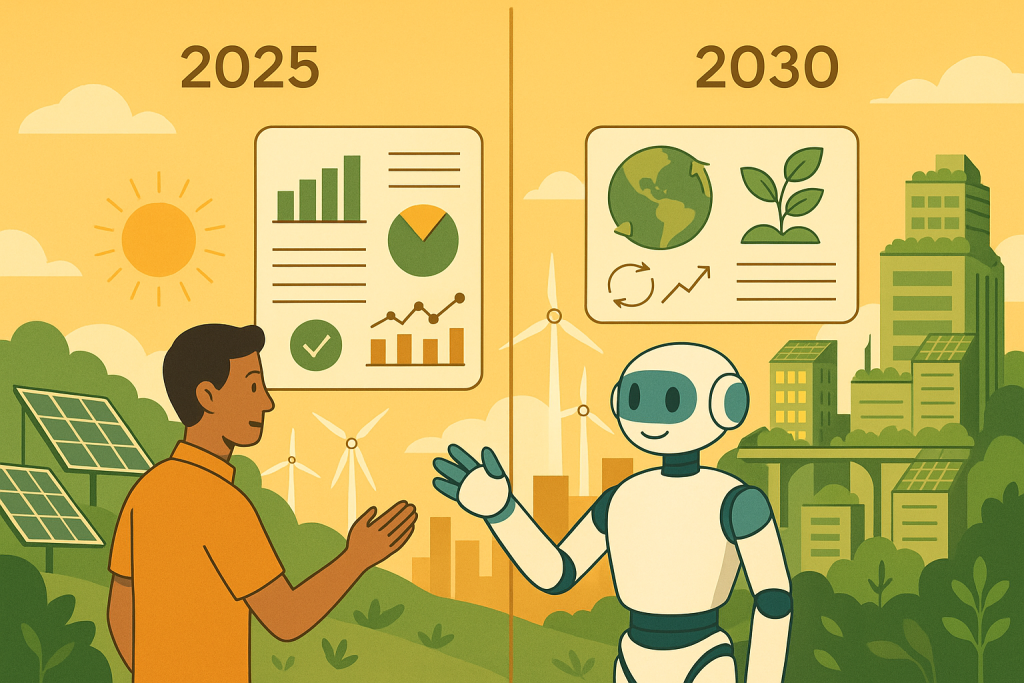🌍 Intro: The Problem with Today’s Product Footprints
Life Cycle Assessment (LCA) is one of the most powerful tools we have to measure the true environmental impact of products—from raw material extraction to end-of-life disposal. It tells us how much energy is used, how much carbon is emitted, and what the social or ecological costs are at every stage.
But here’s the catch: LCA is often slow, fragmented, and backward-looking. It requires complex modeling, hard-to-access data, and deep expertise. Most companies either don’t do it at all or do it only for compliance.
What if that changed?
What if AI turned LCA into a real-time, predictive, and democratized intelligence system—empowering everyone from product designers to consumers to make choices that help, not harm, the planet?
⚡ Quick Summary
- LCA today is limited by data gaps, static modeling, and manual labor.
- AI can turn LCA into a dynamic, predictive, and automated system.
- This means real-time eco-scorecards, generative design optimization, and global product sustainability ratings.
- Use cases include ESG reporting, circular supply chain design, and personalized consumer feedback.
- The future of LCA is not a spreadsheet—it’s an intelligent sustainability engine.
🤖 From Static Reports to Living Intelligence: AI’s Transformative Role
1. Automated Data Harvesting Across the Product Chain
AI models can pull structured and unstructured data from sensors, supplier portals, customs declarations, even satellite imagery. This turns LCA from a periodic audit into a live feed of environmental impact.
Example: A fashion brand uses AI to analyze cotton sourcing data from satellite images and blend it with factory-level energy metrics, all in real time.
2. Predictive LCAs for Product Prototypes
Rather than modeling a product after it’s made, AI can simulate hundreds of design options before anything is manufactured. LLMs and AI twins can forecast likely impacts and recommend the lowest-impact designs.
Imagine: You’re designing a new smartphone. An AI suggests materials and suppliers that cut the carbon footprint by 37% before you build a single prototype.
3. Natural Language LCA Interfaces
With AI-powered chat interfaces, sustainability teams (or even interns!) can run LCAs by asking natural-language questions like:
“What’s the water impact of switching from plastic to bamboo for packaging in the EU market?”
This removes the need for specialist software and opens LCA up to small businesses, startups, and global suppliers.
🌱 ESG Dashboards that Think for Themselves
Generative AI can surface anomalies, benchmark against peer companies, and suggest interventions—all with ESG reporting in mind.
AI-Enabled ESG Dashboard Features:
- Auto-generated carbon hot spot alerts
- Supplier risk ratings based on environmental violations
- AI summaries of upstream Scope 3 emissions
- Dynamic visuals and regulatory compliance insights
These aren’t static PDFs. They’re living dashboards that evolve with your supply chain.
🌀 Circular Economy: AI as the Operating System
To close the loop, LCA needs to be fast and fine-grained enough to detect circularity bottlenecks: which parts can be reused, remanufactured, or recycled.
AI models can track product composition, usage data, and recovery potential—then suggest logistics for circular flows.
Use Case: An electronics company uses AI to predict which laptop parts are easiest to recover and where to send them for disassembly, maximizing reuse and minimizing waste.
🌐 Global Product Sustainability Index?
With standardized, AI-enabled LCAs across industries, we could one day see a real-time Global Product Sustainability Index—a kind of ESG “nutrition label” for every product.
You could scan a product in a store and get:
- Its carbon, water, and toxicity scores
- Comparisons to industry averages
- A breakdown of how the company is addressing ESG issues
Imagine buying with intelligence, not just price.
🧠 Visionary Forecast: The LCA Singularity
In 5–10 years, AGI-level systems could fully model the Earth’s material flows and simulate the sustainability impact of any economic decision—at speed and scale.
Every factory, port, and product becomes a node in a planetary intelligence network that learns how to balance growth and regeneration.
We won’t just track impacts—we’ll orchestrate sustainable futures.
✨ Conclusion: LCA as a Living Brain for Sustainability
AI is not just a tool—it’s a translator between human intention and planetary boundaries. With it, LCA evolves from a bureaucratic box-check into a strategic compass for regenerative design, policy, and consumption.
The future of LCA is living, learning, and co-evolving with the planet.
Are we ready to build it?



